Dakshina Kannada
Dakshina Kannada is a district in the state of Karnataka in India. Mangalore is the headquarters. It is sheltered by the Western Ghats on the east and surrounded by the Arabian Sea on the west, Dakshina Kannada receives abundant rainfall during the monsoon. It is bordered by Udupi district ( formerly a part of this district) to the north, Chikmagalur district to the northeast, Hassan district to the east, Kodagu to the southeast and Kasaragod district of Kerala to the south. According to the 2011 census of India, Dakshina Kannada district had a population of 2,083,625. Dakshina Kannada district is the second major district of Karnataka in all aspects after Bangalore Urban. It is the only district in Karnataka state to have all modes of transport like road, rail, water and air due to the presence of a major hub, Mangalore. This financial district is also known as the Cradle of Indian banking.
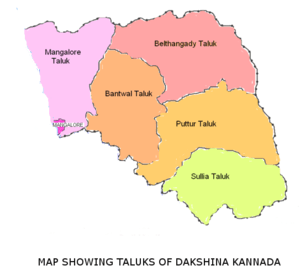
Dakshina Kannada | |
|---|---|
District | |
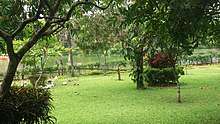  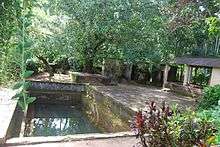  Clockwise from top: Pilikula Botanical Garden, Bendru Theertha, Moodabidri, Bandaje Falls, Charmadi Ghat | |
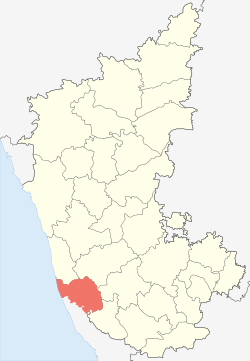 Location of Dakshina Kannada in Karnataka | |
| Coordinates: 12.87°N 74.88°E | |
| Country | |
| State | Karnataka |
| Region | Tulu Nadu |
| Headquarters | Mangalore |
| Talukas | Mangalore, Sullia, Puttur, Belthangady, Moodabidri, Bantwal and Kadaba |
| Government | |
| • Deputy Commissioner | K V Rajendra[1] |
| • MP | Nalin Kumar Kateel[2] |
| Area | |
| • Total | 4,559 km2 (1,760 sq mi) |
| Highest elevation | 1,115 m (3,658 ft) |
| Population | |
| • Total | 2,089,649[3] |
| • Density | 457/km2 (1,180/sq mi) |
| Languages | |
| • Official | Kannada |
| • Regional | Tulu, Konkani, Urdu, Malayalam, Beary, Havyaka, Are Bhashe |
| Time zone | UTC+5:30 (IST) |
| PIN | |
| Telephone code | + 91 (0824) |
| Vehicle registration | KA-19 (Hampankatta, Mangalore south), KA-21 (Puttur, Sullia, Belthangady), KA-62 (Surathkal, Mangalore north), KA-70 (B C Road) |
| Airport | Mangalore International Airport |
| Seaport | New Mangalore Port |
| Website | www |
The district comprises seven talukas: Mangalore, Bantwal, Puttur, Sullia, Belthangady, Kadaba and Moodabidri. It used to include seven northern talukas (Udupi, Kundapur, Karkala, Hebri, Brahmavar, Kaup and Byndoor), but these were separated in August 1997 to form Udupi district.
Important cities and towns in Dakshina Kannada include Mangalore, Puttur, Sullia, Bantwal, Vittal, Moodabidri, Kinnigoli, Uppinangady, Nellyadi, Kadaba, Belthangady, Guruvayankere, Venur, Mulki, Dharmasthala, Ujire and Subramanya. The district is known for beaches, red clay roof tiles (Mangalore tiles), cashew nut and its products, banking, education, healthcare and cuisine. Mangalore being the second largest city of Karnataka and Puttur are the largest and the major cities of Dakshina Kannada.
History
The Alupas (ಅಲುಪಾಸ್) ruled the erstwhile Dakshina Kannada region between the 8th and 14th century CE.[4] Before 1860, Dakshina Kannada was part of a district called Kanara, which was under a single administration in the Madras Presidency.[5] In 1860, the British split the area into South Kanara and North Kanara, the former being retained in the Madras Presidency, while the latter was made a part of Bombay Presidency in 1862.[6] Kundapur Taluk was earlier included in North Kanara but was later re-included in South Kanara.[7]
During the Reorganisation of States in 1956, Kasaragod was split and transferred to the newly created Kerala state and Dakshina Kannada was transferred to Mysore State (present day Karnataka).[8]
South Canara was a district under the British empire which included the present Dakshina Kannada, Udupi, Kasaragod districts and Aminidivi islands.[9][10] Canara district was bifurcated in 1859 to form North Canara and South Canara.[11] Dakshina Kannada became a district of Mysore State in 1956 which later was renamed Karnataka in 1973.[12] Kasaragod became a district of Kerala during the Re-organization of States and Aminidivi islands later became a part of Lakshadweep.[13] The Udupi district was formed from the northern taluks of Dakshina Kannada in 1997.[14] Later, the Karnataka Government, for the purpose of administration, split the greater Dakshina Kannada district into Udupi and present day Dakshina Kannada districts on 15 August 1997.[15] Three taluks of the former district – Udupi, Karkala and Kundapura – formed the new Udupi district.[16]
Demographics

According to the 2011 census, Dakshina Kannada has a population of 2,089,649, of which male and female were 1,034,714 and 1,054,935 respectively.[3] roughly equal to the nation of Macedonia.[17] This gives it a ranking of 220th in India (out of a total of 640).[3] The district has a population density of 457 inhabitants per square kilometre (1,180/sq mi).[3] Its population growth rate over the decade 2001-2011 was 9.8%.[3] Dakshina Kannada has a sex ratio of 1018 females for every 1000 males[3] and a literacy rate of 88.62%. The literacy rate of Mangalore city is 94%.[3] According to the 2011 Indian Census, the district ranks second in per capita income,[18] second in HDI,[19] first in literacy[20] and third in sex ratio among all districts in Karnataka. 7.1% of the district's population is Scheduled Castes and 3.9% Scheduled Tribes.[21]
Tuluvas, distributed among the Billava, Mogaveera, Bunt, Kulala, Tulu Gowda and Devadiga communities, are the largest ethnic group in the district.[22] The Konkani people, Brahmins, Holeyas, the hill-tribes (Koragas), Muslims, Mangalorean Catholics and Arebhashe Gowdas comprise rest of the population.[23] The Brahmins belong chiefly to the Shivalli, Saraswat, Vishwakarma, Havyaka, Chitpavan, Daivadnya and Kota sub-sections.[24] The major languages spoken in Dakshina Kannada are Tulu, Konkani, Kannada, Beary Bhashe, Malayalam, Are Bhashe, Deccani Urdu and Havyaka.[25]
| Year | Pop. | ±% p.a. |
|---|---|---|
| 1901 | 485,304 | — |
| 1911 | 516,051 | +0.62% |
| 1921 | 546,146 | +0.57% |
| 1931 | 596,400 | +0.88% |
| 1941 | 666,222 | +1.11% |
| 1951 | 755,100 | +1.26% |
| 1961 | 915,039 | +1.94% |
| 1971 | 1,163,668 | +2.43% |
| 1981 | 1,428,028 | +2.07% |
| 1991 | 1,656,165 | +1.49% |
| 2001 | 1,897,730 | +1.37% |
| 2011 | 2,089,649 | +0.97% |
| source:[26] | ||
Geography
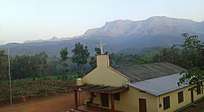 Western Ghats in Shirlalu village of Belthangady taluk
Western Ghats in Shirlalu village of Belthangady taluk.jpg) Hilly region - Sullia Town
Hilly region - Sullia Town- Coastal plain - Tannirbhavi Beach
The district geography consists of seashore in the west and Western Ghats in the east. The soil is mostly lateritic type, characterised by high iron and aluminium content.[27]
The major rivers are Netravathi, Kumaradhara, Gurupura (Phalguni), Shambhavi, Nandini or Pavanje and Payaswini; all join the Arabian sea.[28] At Uppinangadi, the Netravathi and Kumaradhara rivers rise during the monsoon and meet. This event is called "Sangam", which in Sanskrit means confluence.[29] Near Mangalore, an estuary is formed by the union of the rivers Netravathi and the Gurupura which merge into the Arabian Sea.[30]
The topography of the district is plain up to 30 km (18.64 mi) inside the coast and changes to undulating hilly terrain sharply towards the east in the Western Ghats.[31] Teak, bamboo and rosewood trees are found in the hilly areas towards the east.[32] The Geological Survey of India has identified this district as a moderately earthquake-prone region and categorised it in the Seismic III Zone.[33] In rural Dakshina Kannada, houses are in the midst of a farm field or plantations of coconut or arecanut, separated by a few hundred metres.[34]
Shirlalu village (in the Kudremukh range of Belthangady taluk[35]), with a maximum elevation of 1,115 m (3,658 ft), is the highest point in Dakshina Kannada.[36][37]
Climate
Dakshina Kannada features a Tropical Monsoon climate (Am) according to the Köppen climate classification.[38] The average annual rainfall in Dakshina Kannada is 4,030 millimetres (159 in).[28] The rainfall varies from 3,774.1 millimetres (149 in) at the Mangalore coast, 4,530 millimetres (178 in) at Moodabidri and 4,329 millimetres (170 in) at Puttur near the Western Ghats.[39] The average humidity is 75% and peaks in July at 89%.[40]
| Climate data for Mangalore (1961–1990, extremes 1901–1981) | |||||||||||||
|---|---|---|---|---|---|---|---|---|---|---|---|---|---|
| Month | Jan | Feb | Mar | Apr | May | Jun | Jul | Aug | Sep | Oct | Nov | Dec | Year |
| Record high °C (°F) | 36.3 (97.3) |
37.8 (100.0) |
37.4 (99.3) |
36.6 (97.9) |
36.7 (98.1) |
34.4 (93.9) |
35.6 (96.1) |
32.2 (90.0) |
34.6 (94.3) |
35.0 (95.0) |
35.6 (96.1) |
35.6 (96.1) |
37.8 (100.0) |
| Average high °C (°F) | 31.7 (89.1) |
31.7 (89.1) |
31.9 (89.4) |
32.8 (91.0) |
32.3 (90.1) |
29.9 (85.8) |
28.6 (83.5) |
28.5 (83.3) |
29.2 (84.6) |
30.4 (86.7) |
31.7 (89.1) |
32.0 (89.6) |
30.9 (87.6) |
| Average low °C (°F) | 21.7 (71.1) |
22.7 (72.9) |
24.4 (75.9) |
25.7 (78.3) |
25.4 (77.7) |
23.7 (74.7) |
23.1 (73.6) |
23.1 (73.6) |
23.1 (73.6) |
23.4 (74.1) |
23.0 (73.4) |
22.4 (72.3) |
23.5 (74.3) |
| Record low °C (°F) | 16.7 (62.1) |
16.7 (62.1) |
18.3 (64.9) |
20.0 (68.0) |
18.9 (66.0) |
18.4 (65.1) |
18.0 (64.4) |
19.8 (67.6) |
19.0 (66.2) |
18.8 (65.8) |
17.6 (63.7) |
16.7 (62.1) |
16.7 (62.1) |
| Average rainfall mm (inches) | 0.2 (0.01) |
3.6 (0.14) |
2.5 (0.10) |
35.0 (1.38) |
199.5 (7.85) |
955.8 (37.63) |
1,160.3 (45.68) |
792.6 (31.20) |
331.5 (13.05) |
184.0 (7.24) |
75.2 (2.96) |
33.9 (1.33) |
3,774.1 (148.59) |
| Average rainy days | 0.0 | 0.0 | 0.1 | 2.0 | 7.2 | 24.5 | 29.4 | 25.4 | 15.3 | 10.1 | 4.4 | 1.3 | 119.7 |
| Average relative humidity (%) (at 17:30 IST) | 65 | 68 | 70 | 71 | 73 | 82 | 86 | 85 | 83 | 80 | 71 | 67 | 75 |
| Source: India Meteorological Department[41][42] | |||||||||||||
| Climate data for Puttur, Karnataka, India | |||||||||||||
|---|---|---|---|---|---|---|---|---|---|---|---|---|---|
| Month | Jan | Feb | Mar | Apr | May | Jun | Jul | Aug | Sep | Oct | Nov | Dec | Year |
| Average high °C (°F) | 31.3 (88.3) |
31.8 (89.2) |
32.7 (90.9) |
33.1 (91.6) |
32.4 (90.3) |
29.3 (84.7) |
28.0 (82.4) |
28.2 (82.8) |
28.8 (83.8) |
29.9 (85.8) |
30.8 (87.4) |
31.2 (88.2) |
30.6 (87.1) |
| Average low °C (°F) | 20.8 (69.4) |
22.0 (71.6) |
23.6 (74.5) |
25.2 (77.4) |
25.2 (77.4) |
23.5 (74.3) |
23.0 (73.4) |
23.1 (73.6) |
23.0 (73.4) |
23.2 (73.8) |
22.4 (72.3) |
21.0 (69.8) |
23.0 (73.4) |
| Average rainfall mm (inches) | 0 (0) |
1 (0.0) |
6 (0.2) |
63 (2.5) |
208 (8.2) |
938 (36.9) |
1,489 (58.6) |
858 (33.8) |
386 (15.2) |
277 (10.9) |
81 (3.2) |
22 (0.9) |
4,329 (170.4) |
| Source: Climate-Data.org - Climate Table of Puttur, Karnataka, India[39] | |||||||||||||
Education and research
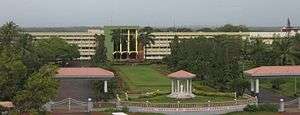

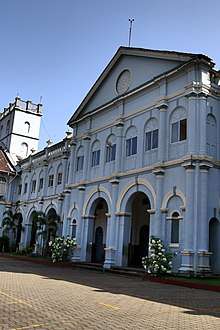
In Dakshina Kannada, primary and secondary education have reached every section of the society.[43][44] A host of educational institutes offering courses in Medicine, Engineering, Pharmacy, Nursing, Hotel and Catering, Law and Management are in this district.[45]
Dakshina Kannada is home to the National Institute of Technology Karnataka (NITK) Surathkal, one of India's top engineering colleges.[46] The College of Fisheries is located at Yekkur near Kankanady.[47][48] Mangalore University is a public university in Konaje near Mangalore.[49] It has jurisdiction over the districts of Dakshina Kannada, Udupi and Kodagu.[50]
The district is home to research institutes such as the Directorate of Cashew Research at Puttur.[51] The Central Plantation Crops Research Institute is in Vitla in the Bantwal taluk.[52]
The engineering colleges in the district include St. Joseph Engineering College, KVG College of Engineering, Mangalore Institute of Technology & Engineering, Canara Engineering College, P A College of Engineering, Srinivas Institute of Technology, Srinivas School of Engineering, Vivekananda College of Engineering & Technology, Shree Devi Institute of Technology, Alvas Institute of Engineering & Technology, Karavali Institute of Technology, Sahyadri College of Engineering and Management, Yenepoya Institute of Technology, A J Institute of Engineering and Technology,[53] SDM Institute of Technology, Bearys Institute of Technology and Prasanna College of Engineering & Technology.[54]
The medical colleges in the district include A J Institute of Medical Science, Father Muller Medical College, KS Hegde Medical Academy, Kasturba Medical College, Srinivas Institute of Medical Sciences and Research Centre, Yenepoya Medical College & Research Institute and KVG Medical College. Manipal College of Dental Sciences Mangalore, A B Shetty Memorial Institute of Dental Sciences, A J Institute of Dental Sciences, Yenepoya Dental College & Research Institute and Srinivas Institute of Dental Sciences are some of the dental colleges.[55]
Cultures, traditions and rituals
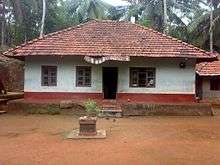
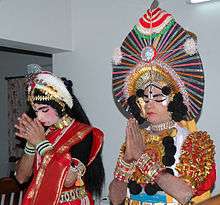
Most people of this district follow traditions, customs and rituals.[24] The district has many temples of Hindu gods and goddesses, which are ancient and have deep spiritualism attached to them. The people of Dakshina Kannada worship the Serpent God Subramanya.[56] According to legend, the district was reclaimed by Parashurama from the sea.[57] Nagaradhane or snake worship is practiced according to the popular belief of the Naga Devatha to go underground and guard the species on the top.[58] Rituals such as Bhuta Kola are performed to satisfy the spirits. Kambala, a form of buffalo race on muddy track in the paddy field is organised in 16 sites across the district.[59] Cock fight (Kori Katta in Tulu) is another pastime of the rural agrarian people.[60]
Yakshagana is the popular folk art of this district.[61] The Yakshagana is a night-long dance and drama performance practiced in Tulu Nadu with great fanfare.[62][63] Pilivesha (literally, tiger dance) is a unique form of folk dance in the region fascinating the young and the old alike, which is performed during Dasara and Krishna Janmashtami.[64] Karadi Vesha (literally, bear dance) is another popular dance performed during Dasara.[65][66] The people of Dakshina Kannada also celebrate traditional Hindu festivals like Bisu, Yugadi (Ugadi), Krishna Janmashtami, Ganesha Chaturthi, Navaratri (Dasara), Deepavali, Aati Hunime, etc.[67][68]
Transport
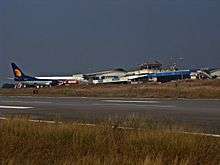
Bus services in this district are run by private players namely Dakshina Kannada Bus Operators' Association (DKBOA)[69] and the state-run KSRTC.[70] The district had public limited (public listed) companies running transport business even before the independence of India in 1947.[71]
The district has five national highways connecting parts of Karnataka and India. NH-66 connects the district with Udupi, Karwar, Mumbai, Goa, Kochi and Thiruvananthapuram.[72] NH-169 connects Shimoga with Dakshina Kannada.[73] NH-75 connects the district with Vellore, Kolar, Bangalore, Kunigal, Hassan and Sakleshpur.[74] The NH-73 connects Mangalore to Tumkur via Charmadi, Mudigere, Belur and Tiptur. Major ghat sections in Dakshina Kannada include Shiradi Ghat (Nelyadi to Sakleshpura), Charmadi Ghat (Charmadi to Kottigehara), Sampaje Ghat (Sampaje to Madikeri) and Bisle Ghat (Subramanya to Sakleshpura, popularly known as Green Route by trekkers).[75] NH-275 also connects Mangalore with Bangalore via Mysore.[76] It starts at Bantwal near Mangalore city and passes through Puttur, Madikeri, Hunsur, Mysore, Mandya and Channapatna.[77] It ends at Bangalore spanning a length of 378 kilometres (235 mi).[78]
|
Highway |
Starting Point |
Ending Point |
|---|---|---|
| National Highway 66 (previously NH 17) | Panvel, Maharashtra | Kanyakumari, Tamil Nadu |
| National Highway 75 (previously NH 48) | Mangalore | Vellore, Tamil Nadu |
| National Highway 275 | Mangalore | Bangalore |
| National Highway 169 (previously NH 13) | Mangalore | Shimoga |
| National Highway 73 | Mangalore | Tumkur |
In 1907, the Southern Railway connected Mangalore with Calicut (Kozhikode) along the coastline.[79] This railway line helped connect the district with other places of the Madras presidency during the colonial rule.[80] The Konkan Railway (1998) connects Dakshina Kannada with Maharashtra, Goa, Gujarat, Delhi, Rajasthan and Kerala by train.[81] There are direct trains from Mangalore to Mumbai, Thane, Chennai, Margao and Trivandrum.[82] Train services operate daily to Bangalore via Hassan and Kukke Subramanya after the conversion from metre gauge to broad gauge track.[83]
The Dakshina Kannada district has a seaport at Panambur named New Mangalore Port. The seaport managed by New Mangalore Port Trust handles cargo, timber, petroleum and coffee exports.[84] It is one of the major seaports of India.[85]
The district is connected by air through the Mangalore International Airport at Bajpe. Airlines such as Air India, SpiceJet and IndiGo offer daily flights to national and international destinations near the Persian Gulf.[86]
Historic sites
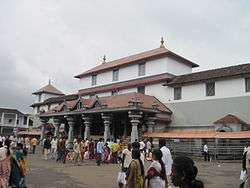 Sri Manjunatha Temple at Dharmasthala
Sri Manjunatha Temple at Dharmasthala Kukke Subramanya Temple
Kukke Subramanya Temple- Shree Durgaparameshwari Temple Kateel
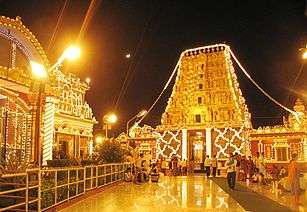 Kudroli Temple in Mangalore
Kudroli Temple in Mangalore Mangaladevi Temple
Mangaladevi Temple
The following are historic places to visit in Dakshina Kannada:[28][87]
- Mangaladevi Temple: Mangalore was named after the Hindu deity Mangaladevi.
- Venur: Monolithic Bahubali statue.
- Kadri: Temple of Lord Sri Manjunatha.
- Shree Amrutheshwara Temple, Vamanjoor: Temple of Lord Shiva.
- Moodabidri: Site of the ancient Jain temples and the Bhattaraka seat.
- Krishnapura matha: One of the matha (monastery) belonging to ashta matha of Udupi.
- Dharmasthala: The temple of Lord Sri Manjunatheshwara is here.
- Kateel: Temple of Goddess Sri Durga Parameshwari.
- Kadeshivalaya: Kadeshivalaya temple at Bantwal
- Kudroli: Gokarnanatheshwars Temple.
- Mundkur: Sri Durga Parameshwari Temple.
- Karinjeshwara Temple: Temple of Lord Shiva Parvati on a huge rock.
- Ullal: Known for the Ullal beach and Someshwara beach.[88]
- Kukke Subramanya: Temple of the serpent Lord Subramanya is here.
- Mulki: Durgaparameshwari Temple.
- St Aloysius Chapel, Mangalore.[88]
- Milagres Church, Mangalore[88]
- Sayyed Madani Mosque and Dargah, Ullal.[88]
- Sultan Battery, Mangalore[88]
- Puttur: Temple of Lord Sri Mahalingeshwara is here.
- Uppinangadi: Sahasralingeshwara temple.
- Kepu, Ananthadi, Balnadu: Known for goddess Ullalthi temple and its unique heritage.[88]
- Puttur karavadtha valiyullahi darga shareef
- Somanatheswar Temple: Someshwara, Ullal.
- Summer Sand Beach Resort at Ullal.[88]
- Pilikula Nisargadhama: Pilikula, Moodushedde, Mangalore.[89]
- Kudupu temple: Kudupu, Mangalore.[88]
- Shri Rajarajeshwari Temple Polali: Temple of Shri Rajarajeshwari.[90]
- Kumbladi Balasubrahmanya.[88]
- Charvaka Kapileshwara Devasthaana.[88]
- Shri Kshetra Daipila.[88]
- Masjidu Thaqwa Pumpwell Mangalore.[91]
- Bellye Palli (Big Masjid) Bunder Mangalore.[88]
- Manjusha Car Museum, Dharmastala
- Srimanthi Bhai Memorial Government Museum
Agriculture
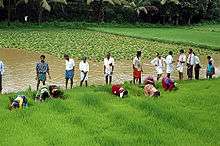

Agriculture, which was once a major occupation of the people of Dakshina Kannada, has taken a backseat because of the influx of money from natives settled in other cities, states and countries.[92] Significant number of people from this district work in the Gulf (Middle East) countries and other states of India.[93] Farms and fields have been converted into residential plots and commercial (shopping) complexes around Mangalore city.[94] Horticulture, though, has made some strides, and measures have been taken to improve the fruit plantation sector.[95] The main crops of Dakshina Kannada are Paddy, Coconut, Arecanut, Black Pepper, Cashew and Cocoa. Rice is generally cultivated three seasons in a year, Karthika or Yenel (May–October), Suggi (October to January) and Kolake (January to April).[96] Urad (Black gram) is grown in some areas during the season of Suggi.[97] The Karnataka Milk Federation has a milk processing plant at Kulshekar in Mangalore. This plant processes milk procured from the cattle owned by farmers of the district.[92]
Cuisine
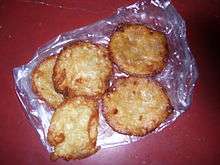
Some of the well known Tuluva community dishes in this district include Kori Rotti (dry rice flakes dipped in chicken gravy), Bangude Pulimunchi (spicy sour silver-grey mackerels), Beeja-Manoli Upkari, Neer dosa, Boothai Gasi and Kadubu.[98] In Coastal Karnataka, the Mangalorean Fish Curry is a popular dish.[99] The Konkani community's specialties include Daali thoy, Bibbe-upkari (cashew based), Val val, Avnas ambe sasam, Kadgi chakko, Paagila podi, Malpuri, Patrode and Chane gashi.[100] Mangalore bajji, also known as Golibaje, is a popular snack made from maida, curd, rice flour, chopped onion, coriander leaves, coconut, cumin, green chillies, and salt.[101] Tulu vegetarian cuisine in Mangalore, also known as Udupi cuisine, is known and liked throughout the state and the coastal region.[102] Being a coastal district, fish forms the staple diet of most people.[103] Mangalorean Catholics' Sanna-Dukra Maas ("Sanna" means Idli fluffed with toddy or yeast and "Dukra Maas" means Pork), Pork Bafat, Sorpotel and the Mutton Biryani of the Muslims are well-known dishes.[104][105] Pickles such as Happala, Sandige and Puli munchi are unique to Mangalore.[106]
Commerce and industry



The district along with Udupi district is known as "The Cradle of Indian banking".[107] Major nationalised banks of India such as Canara Bank, Corporation Bank, Syndicate Bank, Vijaya Bank and private sector Karnataka Bank evolved from these two districts.[108]
Red clay tiles (Mangalore Tiles), Cashew processing factories and Beedi industry once flourished in this district.[109]
Dakshina Kannada district has a per capita income of Rs. 218,580 which is second only to Bangalore Urban district.[110][111] Despite ranking 8th in the list of most populous districts in Karnataka, the district is the second largest contributor to the state's GSDP, with a contribution of 5.8%.[110] In other words, despite a low population share of 3.4%, the district's share in state GSDP stands at 5.8%.[110]
As the district is on the shore of the Arabian sea, fishing is one of the major occupation of many people.[112] The major fishing places are Bunder (Old harbour),[113] Panambur, Surathkal, Kotekar and Sasihitlu.
The major industries in Dakshina Kannada concentrated around Mangalore are Mangalore Chemical and Fertilizers Ltd. (MCF), Kudremukh Iron Ore Company Ltd. (KIOCL),[114] The Canara Workshops Limited (manufacturers of Canara Springs), Mangalore Refinery and Petrochemicals Ltd. (MRPL), HPCL, BPCL,[115] BASF, TOTAL GAZ, Bharati Shipyard Limited (BSL) etc.[116] There is a chocolate manufacturing plant at Puttur run by CAMPCO.[117] Major information technology and outsourcing companies have their facilities in Mangalore namely Infosys, Cognizant, Atlantic Data Bureau Services Pvt. Ltd., Lasersoft infosystems Ltd., Mphasis BPO and Endurance International Group.[118] Two IT parks have been constructed, one Export Promotion Industrial Park (EPIP) at Ganjimutt and a second IT SEZ near Mangalore University.[119] The Oil and Natural Gas Corporation (ONGC) plans to set up a multiproduct SEZ (Special Economic Zone) with an investment of over Rs. 350 billion.[120]
See also
- Mangalore
- Economy of Mangalore
- Swami Vivekananda Planetarium
- U S Mallya Indoor Stadium
- Karnataka Urban Development and Coastal Environment Management Project (KUDCEMP)
- Centre for Entrepreneurship Opportunities and Learning (CEOL)
- South Kanara District Chess Association (SKDCA)
- Puttur
- Sullia
- Bantwal
- Belthangady
- Kakkinje
- Moodabidri
- Dharmasthala
References
- "Rajendra takes over as DC of Dakshina Kannada". The Hindu. 30 July 2020. Retrieved 10 August 2020.
- "Nalin Kumar Kateel takes charge as Karnataka BJP chief". The Economic Times. 16 January 2020. Retrieved 4 May 2020.
- "Dakshina Kannada District : Census 2011 data". Census 2011. Retrieved 6 October 2017.
- Bhat, N. Shyam (1998). South Kanara, 1799–1860: a study in colonial administration and regional response. Mittal Publications. ISBN 978-81-7099-586-9.
- Rangacharya, V. "Inscriptions of the Madras Presidency" (PDF). Archived from the original (PDF) on 25 May 2015. Retrieved 25 May 2015.
- "History". Imperial Gazetteer of India. 14. South Kanara. p. 357.
- "Imperial Gazetteer of India" (PDF). Retrieved 6 October 2017.
- "States Reorganization Act 1956". Commonwealth Legal Information Institute. Archived from the original on 16 May 2008. Retrieved 1 July 2008.
- Rangacharya, V. "Inscriptions of the Madras Presidency".
- "Template for district gazetteer - Lakshadweep" (PDF). National Informatics Centre, Lakshadweep. Retrieved 5 October 2017.
- Kumar N I, Fedrick Sunil. "The Basel Mission in South Canara" (PDF). Department of History, University of Calicut, 2006. Retrieved 6 October 2017.
- "Regional culture of Karnataka is diverse, unique: DC". Deccan Herald. 1 November 2019. Retrieved 14 December 2019.
- M, Amruth. "Forest-Agriculture Linkage and its Implications on Forest Management: A study of Delampady panchayat, Kasaragod district, Kerala" (PDF). Kerala Research Programme on Local Level Development Centre for Development Studies. Retrieved 6 October 2017.
- Patsy Lozupone, Bruce M. Beehler, Sidney Dillon Ripley.(2004).Ornithological gazetteer of the Indian subcontinent, p. 82. Center for Applied Biodiversity Science, Conservation International. ISBN 1-881173-85-2.
- "Chapter III - Profile of Karnataka state" (PDF). Shodhganga. Retrieved 5 October 2017.
- Bhat, N. Shyam. "South Kanara, 1799-1860: A Study in Colonial Administration and Regional Response".
- US Directorate of Intelligence. "Country Comparison - Population". Retrieved 6 October 2017.
- "Karnataka slips to 6th spot in Per Capita Income". The New Indian Express. 20 October 2015. Retrieved 6 October 2017.
- "HDI: Bengaluru Urban, DK, Udupi top list". The New Indian Express. 20 October 2015. Retrieved 6 October 2017.
- "It's official: State's population is 6.10 cr, Dakshina Kannada most literate district". Daijiworld. 24 May 2016. Retrieved 6 October 2017.
- "Bangalore has Lowest Sex Ratio, DK Highest Literacy Rate in State". Daijiworld. 6 April 2011. Retrieved 6 October 2017.
- "Imperial Gazetteer of India, South Kanara". dsal.uchicago.edu. Retrieved 4 September 2009.
- "Mangaluru: It has come a long way". The Hindu. 18 July 2007. Retrieved 6 October 2017.
- "Chapter-3 Village: Land, Culture and Ecology" (PDF). Shodhganga. Retrieved 21 June 2015.
- "In Mangaluru, it's private buses all the way". The Hindu Business Line. 11 February 2019. Retrieved 14 December 2019.
- Decadal Variation In Population Since 1901
- "Ground Water Information Booklet - Dakshina Kannada" (PDF). Government of India - Ministry of Water Resources. November 2009. Retrieved 6 October 2017.
- "Dakshina Kannada District Profile" (PDF). Government of Karnataka. Archived (PDF) from the original on 22 February 2015. Retrieved 22 February 2015.
- "Kumaradhara, Nethravathi rivers merge at Uppinangady". Deccan Herald. 19 July 2009. Retrieved 5 October 2017.
- Shruthi, M S; Rajashekhar, M (30 January 2009). "Ecological observations on the phytoplankton of Nethravati - Gurupura estuary, south west coast of India" (PDF). Journal of the Marine Biological Association of India. Marine Biological Association of India. 55 (2): 41–47. doi:10.6024/jmbai.2013.55.2.01768-07.
- Mausam: quarterly journal of meteorology, hydrology & geophysics. 56. India Meteorological Department. 2005. p. 76.
- Santapau, H. "Common Trees" (PDF). Retrieved 25 May 2015.
- Seismic zoning map of India (Map). Geological Survey of India. Retrieved 5 October 2017.
- "Forest - State of the Environment Report - 2003 (Page 189)" (PDF). Parisara. Retrieved 6 October 2017.
- "It's veteran vs political novice in Belthangady". Deccan Herald. 27 April 2013. Retrieved 17 October 2017.
- "Shirlalu - Google Maps".
- "Elevation of Shirlalu village".
- "Climate Table of Moodabidri, Karnataka, India". Climate-Data.org. Retrieved 6 October 2017.
- "Climate Table of Puttur, Karnataka, India". Climate-Data.org. Retrieved 6 October 2017.
- "Average humidity over the year for Mangalore, India". Weather-And-Climate. Retrieved 6 October 2017.
- "Extremes of Temperature & Rainfall for Indian Stations (Up to 2012)" (PDF). India Meteorological Department. December 2016. p. M100–M101. Archived from the original (PDF) on 5 February 2020. Retrieved 10 April 2020.
- "Climatological Normals 1961–1990" (PDF). India Meteorological Department. July 2010. pp. 531–532. Archived from the original (PDF) on 16 February 2020. Retrieved 11 April 2020.
- "Educare Online - Colleges in Dakshina Kannada". Educare Online. Archived from the original on 3 March 2016. Retrieved 7 February 2016.
- "Dakshina Kannada pips Udupi to top in PU performance". The Hindu. 9 May 2014. Retrieved 6 October 2017.
- Madhyastha, M N; Rahman, M Abdul; Kaveriappa, K M (1982). "A brief history of scientific technology, research and educational progress of South Kanara". Indian Journal of History of Science. 17 (2): 260–267.
- "India's 10 top Engineering colleges". Times of India. 23 February 2012. Retrieved 6 October 2017.
- "College of Fisheries, Mangaluru". Karnataka Veterinary Animal and Fishereies University. 31 August 2006. Archived from the original on 4 October 2017. Retrieved 6 October 2017.
- "College of Fisheries, Mangalore". Karnataka Veterinary Animal and Fishereies University. Retrieved 6 October 2017.
- Vinayak, AJ (14 June 2019). "Mangalore University to promote rainwater harvesting". The Hindu Business Line. Retrieved 14 December 2019.
- "Mangalore University all set to celebrate jubilee". The Hindu. 8 September 2004. Retrieved 6 October 2017.
- "ICAR: Directorate of Cashew Research, Puttur, Karnataka". DCR. Archived from the original on 3 June 2017. Retrieved 6 October 2017.
- "ICAR: Central Plantation Crops Research Institute". ICAR. Retrieved 6 October 2017.
- "Mangaluru: A J Institute of Engineering and Technology observes Cultural Day". Daijiworld. 11 April 2017. Retrieved 6 October 2017.
- Phadnis, Renuka (20 February 2012). "Colleges around Mangalore join hands for Campus Placements". The Hindu. Retrieved 6 October 2017.
- "Dakshina Kannada to get five hospitals". The Hindu. 8 March 2007. Retrieved 6 October 2017.
- "Hundreds of devotes throng Shiva temples in Dakshina Kannada". The Hindu. 24 February 2009. Retrieved 5 October 2017.
- "History of Mangalore" (PDF). ICICI. Retrieved 6 October 2017.
- Bhat, RK. "Nagarapanchami Naadige Doddadu". Mangalorean.Com. Archived from the original on 9 February 2012. Retrieved 28 January 2008.
- A Panorama of Indian Culture: Professor A. Sreedhara Menon Felicitation Volume - K. K. Kusuman - Mittal Publications, 1990 - p.127-128""
- "Colours of the season". The Hindu. 9 December 2006. Archived from the original on 28 April 2012. Retrieved 9 July 2008.
- "Yakshagana sapthaha to begin at Ujire from Monday". The Hindu. 17 May 2015. Retrieved 6 October 2017.
- "Yakshagana". SZCC, Tamil Nadu. Archived from the original on 17 August 2007. Retrieved 7 December 2007.
- Plunkett, Richard (2001). South India. Lonely Planet. p. 53. ISBN 1-86450-161-8.
- Pinto, Stanley G (26 October 2001). "Human 'tigers' face threat to health". Times of India. TNN. Retrieved 6 October 2017.
- D'Souza, Stephen. "What's in a Name?". Daijiworld. Archived from the original on 5 March 2008. Retrieved 4 March 2008.
- "Tourism potentialities of Dakshina Kannada - A study with reference to Mangalore" (PDF). Retrieved 6 October 2017.
- "A saga of glorious Tulu calendar". Deccan Herald. 18 May 2012. Retrieved 14 December 2019.
- "Vishu festival sets in on traditional note in UAE". Khaleej Times. 14 April 2016. Retrieved 14 December 2019.
- Shenoy, Jaideep (28 March 2014). "Dakshina Kannada Bus Operators' Association (DKBOA) has entered the world wide web". The Times of India. Retrieved 10 March 2019.
- Ray, Aparajita. "Wheels of change turn Karnataka State Transport Corporation into winner". Times of India. Retrieved 6 October 2017.
- "The Beginning". canarasprings.in. Retrieved 6 October 2017.
- Malkarnekar, Gauree (24 February 2017). "4-lane NH 17 will enable high speeds between 80-100kmph". The Times of India. Retrieved 20 October 2017.
- Kamila, Raviprasad (7 July 2014). "Govt. looks to widen three NH stretches". The Hindu. Retrieved 20 October 2017.
- "NH wise Details of NH in respect of Stretches entrusted to NHAI" (PDF). National Highways Authority of India (NHAI). Archived from the original (PDF) on 25 February 2009. Retrieved 4 July 2008.
- Rao, Mohit M. (13 November 2014). "Shiradi Ghat may get a four-lane concrete road". The Hindu. Retrieved 6 October 2017.
- "Bangalore-Mysore highway to be upgraded to six-lane on PPP basis". The Hindu. Retrieved 6 October 2017.
- "Details Of State Highways". Karnataka PWD. Archived from the original on 2 May 2012. Retrieved 19 August 2012.
- "WIDENING & IMPROVEMENTS TO MYSORE BANTWAL ROAD (SH 88)". KRDCL. Retrieved 6 October 2017.
- Radhakrishnan, S. Anil (12 April 2010). "Railways cross a milestone". The Hindu. Retrieved 6 October 2017.
- "Chapter II: Origin and Development of Southern Railway" (PDF). Shodhganga. Retrieved 6 October 2017.
- "A case study of Konkan Railways" (PDF). UNEP - IIM Ahmedabad. Archived (PDF) from the original on 4 March 2016. Retrieved 25 May 2015.
- "Southern Railway to operate special trains". The Hindu. 23 August 2011. Retrieved 6 October 2017.
- "Bangalore-Mangalore train service from December 8". The Hindu. 24 November 2007. Archived from the original on 29 October 2008. Retrieved 2 October 2008.
- "New Mangalore Port Trust (NMPT)". New Mangalore Port. Archived from the original on 23 May 2006. Retrieved 13 October 2006.
- "Chapter 1 - Economic development through ports" (PDF). Shodhganga. Retrieved 6 October 2017.
- "Airports Authority of India". Airports Authority of India. Archived from the original on 8 January 2015. Retrieved 31 January 2015.
- "Tourism in Dakshina Kannada District". Archived from the original on 22 February 2015. Retrieved 22 February 2015.
- "Tourism potentialities of Dakshina Kannada - A study with reference to Mangalore" (PDF). Retrieved 6 October 2017.
- Kamila, Raviprasad (22 April 2015). "New arrivals at Pilikula Botanical Museum". The Hindu. Retrieved 6 October 2017.
- "Home minister appreciates Polali Temple's heritage". Times of India. 10 March 2019. Retrieved 10 March 2019.
- "Mangalore: Newly Constructed 'Takwa Masjid' Inaugurated at Pumpwell". 7 February 2008. Retrieved 6 October 2017.
- "Agriculture Contingency Plan for District: DAKSHINA KANNADA" (PDF). Agricoop. Archived (PDF) from the original on 1 February 2015. Retrieved 31 January 2015.
- Kalyanaraman, Jananie; Koskimaki, Leah (January 2013). "Dakshina Kannada in the Gulf - Research Report No. 6" (PDF). ProGlo. Retrieved 6 October 2017.
- Shenoy, Jaideep (17 January 2015). "Agricultute festival to look at revival of paddy farming in Dakshina Kannada". Times of India. Retrieved 6 October 2017.
- "Clusters formed in Dakshina Kannada to promote fruit plantation crops". The Hindu. Retrieved 6 October 2017.
- "South Kanara". Digital South Asia Library (DSAL). Retrieved 4 September 2006.
- "Chapter 3 - Profile of the study area: Coastal Karnataka" (PDF). Retrieved 6 October 2017.
- Prashanth, G.N. (15 October 2005). "Go for the Mangalore diet". The Hindu. Retrieved 5 October 2017.
- Arumugam, R (30 September 2011). "Mangalore Fish Curry". The Hindu. Retrieved 25 May 2015.
- "Konkani recipes delight visitors at festival". The Hindu. 24 November 2012. Retrieved 5 October 2017.
- M., Raghava (10 April 2012). "Dosas at Indra Bhavan have retained the taste". The Hindu. Retrieved 6 October 2017.
- Phadnis, Aditi (5 May 2004). "In Udupi, food is the greatest binder". Rediff.com. Retrieved 6 October 2017.
- "Typically home". The Hindu. 11 August 2007. Archived from the original on 3 November 2012. Retrieved 5 May 2015.
- "Dukra maas: a savory Mangalorean Catholic Sunday ritual". National Post. Retrieved 6 October 2017.
- "Ramadan flavors fill Mangalorestreets". The Hindu. 12 July 2012. Retrieved 6 October 2017.
- D'Souza, Stephen. "What's in a Name?". Daijiworld Media Pvt Ltd. Mangalore. Archived from the original on 5 March 2008. Retrieved 4 March 2008.
- "Brief history of banking in India". GK Today. 28 January 2017. Retrieved 6 October 2017.
- Gajdhane, Amol (2012). "The Evolution of Banking in India" (PDF). Avishkar – Solapur University Research Journal. 2. Archived from the original (PDF) on 29 May 2015. Retrieved 1 February 2015.
- Nandi, Arindam; Ashok, Ashvin; Guindon, G Emmanuel; Chaloupka, Frank J; Jha, Prabhat (29 March 2014). "Estimates of the economic contributions of the bidi manufacturing industry in India" (PDF). Cite journal requires
|journal=(help) - Prabhu, Nagesh (20 March 2016). "Bengaluru Urban tops State in per capita income, Kalaburagi last". The Hindu. Retrieved 6 October 2017.
- "Life indices: Bengaluru, Dakshina Kannada, Udupi top". Deccan Chronicle. 20 October 2015. Retrieved 6 October 2017.
- "8% rise in fish catch in Udupi, Dakshina Kannada". The Hindu Business Line. 7 June 2013. Retrieved 5 October 2017.
- "Work on Kulai fishing habour expected to comence soon". The Times of India. 13 February 2019. Retrieved 14 December 2019.
- "KIOCL Mangalore plant may get iron ore from Iran". Times of India. 4 August 2014. Retrieved 6 October 2017.
- "Swachh Bharat Abhiyan echoes on seashores too". The Hindu. 18 September 2016. Retrieved 6 October 2017.
- "Mangalore Refinery and Petrochemicals Limited". MRPL. 31 January 2015. Retrieved 6 October 2017.
- "The CAMPCO Ltd". Puttur, Karnataka, India: Campco. 31 January 2015. Archived from the original on 21 January 2015. Retrieved 31 January 2015.
- "Infosys begins work on its second campus near Mangalore". The Hindu. 5 September 2006. Retrieved 6 October 2017.
- "Two more plans for EPIP cleared". The Hindu. 31 August 2006. Archived from the original on 25 October 2012. Retrieved 29 September 2006.
- "ONGC's huge outlay for Mangalore SEZ". The Hindu. 19 September 2006. Retrieved 6 October 2017.
External links
| Wikimedia Commons has media related to Dakshina Kannada district. |
| Look up Dakshina Kannada in Wiktionary, the free dictionary. |